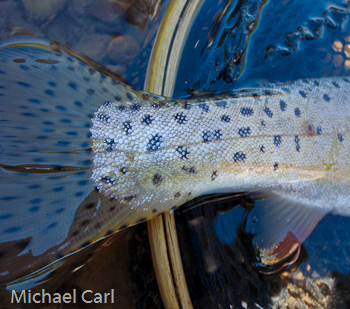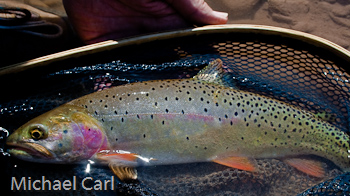Bonneville Cutthroat

Bonnevile cutthroat generally have large, evenly distributed spots, but there is a high degree of intra-basin variation. Bonnevile cutthroat tend to develop large pronounced spots that are more evenly distributed on the sides of the body rather than concentrated posteriorly as in the Yellowstone subspecies. Coloration in Bonnevile cutthroat is generally dull compared to other cutthroat subspecies.

Bonneville average between 16-21 gill rakers, with a mean of 18-19, except the Snake Valley type which have 18-24 (mean, 20-22). Another important characteristic of all cutthroat is the presence of basibranchial teeth which are absent in rainbow trout (Behnke 1992). Numbers of basibranchial teeth provide information about subspecies derivation and relatedness. The Snake Valley type have profuse basibranchial teeth, averaging 20-28, while most other BCT average 5-10 (Behnke 1992).
Bonneville cutthroat trout are thought to have originally evolved from the Yellowstone cutthroat subspecies, one of the three main evolutionary branches of cutthroat trout. Behnke (1979, 1992) postulated that cutthroat trout may have gained access to the Bonneville Basin at multiple times when Lake Bonneville reached varying elevations during past geologic events.
Like most trout, Bonneville cutthroat grow and survive better in relatively cool, well oxygenated water and clean, well sorted gravels with minimal fine sediments for successful spawning. That said, Bonneville cutts have also been found to survive in what is considered marginal salmonid habitat conditions (e.g. turbid water, fine sediments, warmer temperatures, poor structural habitat) (R. Hilderbrand and W. Colyer, pers.comm.). This could be because Bonneville cutthroat have evolved in a desert environment where climate can cause fluctuations in water and sediment regimes and environmental condition (Behnke 1992).
Historic Distribution
The Bonneville cutthroat is native to the Bonneville basin in Idaho, Nevada, Utah and Wyoming. The Bonneville basin covers approximately 132,650 square km within the Great Basin and once contained the largest of the Great Basin's ancient pluvial lakes, Lake Bonneville.

